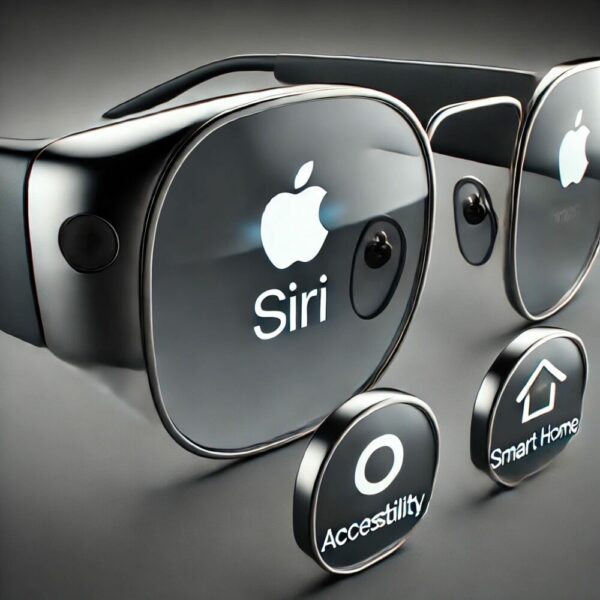Apple has always been at the forefront of technological innovation, creating products that not only captivate the general public but also offer unique benefits for disabled people . With recent reports suggesting that Apple is working on its own smart glasses, there’s no better time to explore the potential impact these wearable devices could have. From enhancing accessibility to creating a new wave of consumer excitement, Apple smart glasses could be the next big thing.
Apple smart glasses
In a recent Power On newsletter, Bloomberg’s Mark Gurman reported that Apple’s Vision group is working on smart glasses similar to the Amazon Echo Frames or the Meta Ray-Bans, which offer some smart audio and AI features. However, Gurman said that the: “idea of making true augmented reality glasses has been tabled due to technical challenges”.
Apple smart glasses features
The first generation of Apple smart glasses, while likely not incorporating advanced augmented reality (AR) features, could still be a groundbreaking device fully integrated into the Apple ecosystem. Here’s a speculative look at the features these glasses might include:
1. Seamless integration with the Apple ecosystem
Apple smart glasses would likely be designed to work seamlessly with other Apple devices, such as iPhones, iPads, Macs, and Apple Watches. Through the existing Apple ecosystem, users could effortlessly sync data, receive notifications, and manage settings across all their devices. The glasses would likely use iCloud to ensure that photos, messages, and other data are instantly available on all linked Apple devices.
2. Siri 2.0 with Apple Intelligence integration
Siri 2.0 could be a significant upgrade, featuring deeper integration with Apple’s AI-driven systems. With these glasses, you might ask Siri, “What am I looking at?” and receive detailed information, suggestions, and even translations. For example, you could be looking at a landmark, and Siri would provide historical data, nearby attractions, or restaurant recommendations. This version of Siri could also interpret and respond to complex commands like, “Find a recipe for the ingredients I’m seeing,” using the camera’s visual input.
3. Smart home control
The glasses would likely include built-in smart home controls, allowing users to manage HomeKit-enabled devices with ease. Imagine walking into a room and simply looking at a lamp while telling Siri to dim the lights. This hands-free control could extend to managing thermostats, locks, and even security cameras, all from your glasses with voice commands.
4. Calls and messaging
Apple smart glasses would offer basic communication features, such as making and receiving calls and messaging hands-free. You will be able to use your voice to call, message and send photos to your WhatsApp, Messenger and phone contacts.
5. Music and advanced open-ear speaker technology
Apple could integrate cutting-edge open-ear speaker technology into the glasses, providing high-quality sound while allowing users to stay aware of their surroundings. This would be perfect for listening to music, podcasts, or even making phone calls without the need for additional earbuds. Given Apple’s track record with audio products like AirPods, the sound quality could be exceptional, offering rich bass and clear treble in a discreet package. Smart glasses with open ear speaker technology could offer alternative for those who find AirPods uncomfortable, or constantly fall out.
6. Integrated camera
A built-in camera could allow users to document their experiences hands-free. You might snap photos or record videos with a simple voice command or gesture, making it easy to capture moments on the go. The camera might also integrate with Apple’s computational photography technology, delivering high-quality images and videos comparable to what the latest iPhones offer. Sharing these moments directly from your glasses via social media or messages would be seamless, making it easier to stay connected without pulling out your phone.
The accessibility revolution
Having used the Ray-Ban Meta smart glasses myself I’ve experienced firsthand how transformative smart glasses can be for disabled people like me. These glasses offer hands-free voice control, which is invaluable for someone with mobility impairments. For those of us with severe disabilities, smart glasses are more than just a cool gadget—they’re a powerful tool of empowerment. They simplify everyday tasks, provide independence, and fit seamlessly into daily life. Apple, with its track record of designing accessible products, is perfectly positioned to take this technology to the next level.
Smart glasses empower disabled people to capture and share their experiences. In this video, I demonstrate the accessibility benefits of smart glasses by taking a hands-free video outside Tate Britain Gallery in London.
I have little use of my arms and hands due to muscular dystrophy, but with just a voice command, smart glasses allow disabled users like me to film and document our lives without needing to handle a phone. Watch to see how this technology can transform lives.
Why Apple needs to enter the market
While current smart glasses have made significant strides, there’s still room for improvement, particularly in terms of design, usability, and integration with other devices. Apple’s expertise in creating intuitive, user-friendly products could bridge this gap. By launching their own smart glasses, Apple could offer a product that appeals not only to tech enthusiasts but also to the accessibility community. The seamless integration with Apple’s ecosystem, including Siri, iOS, Home control, and other smart devices, could create a user experience that is unparalleled in the market.
Wide consumer appeal
Beyond accessibility, Apple’s smart glasses could capture the imagination of a broad consumer base. While as a first step Apple should concentrate on what is technically possible now, further down the line the appeal of augmented reality (AR), hands-free navigation, and real-time information could resonate with anyone looking to enhance their daily tech experience. Whether it’s for gaming, work, or social interaction, smart glasses offer a new way to engage with the world. Apple’s ability to create products that blend function with style could make their smart glasses a must-have accessory for millions.
The potential market impact
Apple’s entry into the smart glasses market could also spur competition, leading to rapid innovation and improvements across the industry. As more companies enter the space, the cost of the technology could decrease, making it more accessible to a wider audience. This, in turn, would drive adoption rates, making smart glasses a common sight in everyday life.
Conclusion
The introduction of smart glasses by Apple could be a game-changer, not just for tech enthusiasts but especially for disabled people who stand to gain the most from this innovation. By combining accessibility with broad consumer appeal, Apple has the potential to redefine what smart glasses can do and who they can benefit.
As we look to the future, the integration of smart glasses into our daily lives seems not only possible but inevitable. Once you’ve experienced the convenience of hands-free calls, messages, photos, and videos with smart glasses, there’s simply no going back.
While Apple is known for entering the market later than others, when it does, it perfects the experience and sets a new standard. It’s only a matter of time before Apple leads the charge, making smart glasses an essential part of our daily lives.






